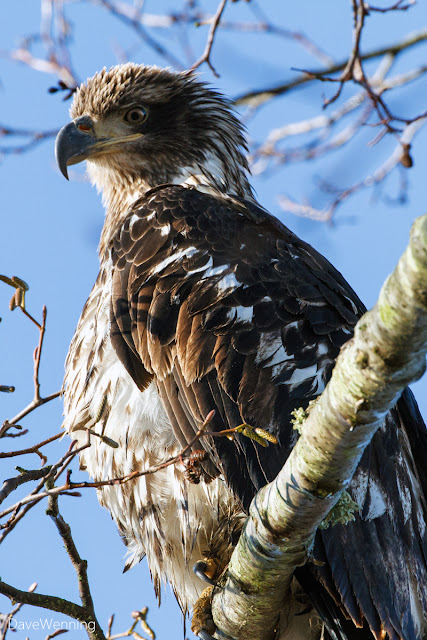Eagle Morning
Last week, I drove over to Fir Island to visit the Skagit Wildlife Area wetlands. It had been closed for several weeks for construction of a new pumping station. I was glad to be able to get in there once again. This is part of a complex system of dikes and drainage sloughs that prevent Fir Island farmlands from being flooded by the Skagit River. Fir Island is actually the Skagit River delta where it flows into Puget Sound.
This portion of the delta is a state wildlife refuge administered by the Washington Department of Fish and Wildlife. Mixed uses include hiking, duck hunting, bird watching and dog training. It offers the unique feature of hiking out into the wetlands atop the spur dike. There has been an ongoing program of restoration here to improve Chinook salmon spawning and rearing habitat. This has become one of my favorite places to explore and view wildlife.
On last week's visit, everywhere I looked, there were Bald Eagles (Haliaeetus leucocephalus). There were mostly juveniles, but also a few adults. Altogether, I saw ten to fifteen birds either perching or flying.
The bird in the first photo was the only one I could get fairly close to. He was perched about 20 feet/6 meters directly above the dike trail. He was surprisingly tolerant of me walking beneath him. The rest of them were quite far out in the marshes. To get photos, I had to strain the limits of the camera and lens, and then do some cropping to bring them in closer.
I met the Fish and Wildlife guy at the new pumping station. He wasn't sure why there were so many eagles around the site. He said they often hang around to snag the injured ducks that are lost by the hunters. But there has been no hunting due to the construction closure.
I spotted this one landng out in the tidal marshes. At the time, I didn't notice the second bird flying just above the cattail line.
This is another view of the juvenile bird in the first photo. He had me going for a while. With so much white on the breast I started to doubt he was a Bald Eagle. Was he really a juvenile Red-tailed Hawk? But then I realized that was the beak of an eagle, not a hawk. Also, this bird was twice the size of any Red-tailed Hawk I had ever seen. This was a Bald Eagle juvie with a lot of white.
While I was watching, he apparently spotted breakfast. He took a run, but then looped around and returned to the same perch with empty talons. Not every attempt at prey is successful.
I found something else interesting along the dike trail. This partial bird carcass was skewered on a twig. I knew the Loggerhead Shrike did this with its prey, but they don't occur here. The Northern Shrike, however, is a rare winter visitor. Shrikes have the habit of storing their prey in this manner for later consumption. Could this be what I was seeing? Sometimes we don't actually see wildlife, but instead, find evidence that it has been around.
This is a new blind on Wiley Slough that Fish and Wildlife has installed for bird watchers. The sign on the back indicates no hunting allowed from this one. Inside, a couple of chairs have been thoughtfully provided.
Mount Baker stands watch over the Skagit Wildlife Area wetlands.









